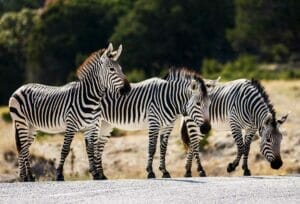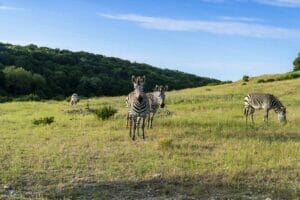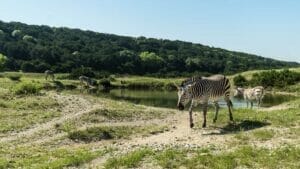
Appearance
Although the Hartmann’s Mountain zebra shares the classic striped patterns of their relatives, their dark fur is more chocolate brown in color than black. This zebra can be easily differentiated from Plains and Grevy’s zebras thanks to their small dewlap, or loose hanging skin, under their chins, as well as their unique body type. Hartmann’s are a stocky species, with shorter legs and wider bodies, as well as hooves that are made to navigate steep, rocky terrain.
Adaptations
In the wild, Hartmann’s Mountain zebras live in arid, rocky landscapes. Nevertheless, they need water and will seek it from springs and rainwater pools. If surface water is not available, they will dig into the ground to attempt to reach groundwater, leading to the creation of new water sources for other species.
Their range is long and wide, and can encapsulate more than 62 miles. Even when fenced, these zebras are known to migrate over all available land. They are skilled climbers and have very hard and pointed hooves compared to other zebras and equids.
Hartmann’s mountain zebras are known for their playful demeanor compared to other zebra species. Members of herds can often be seen engaging in challenge games and other play behavior, namely chasing, racing, play-fighting.
Dazzling Camouflage
It’s thought that zebra’s stripes serve as a unique form of camouflage in the African heat. When temperatures rise, refraction can make air appear wavy. This wavy air, combined with a dazzling stripe pattern, can make it quite difficult to see where the zebra starts and ends. Predators will be unable to distinguish individuals to target, therefore discouraging them from going after a herd.
Where are they?
They live in the fourth pasture you enter. They are often seen in the wide-open, lower areas of pasture.
VIEWING TIPS
Zebras are known to approach cars and chew on vehicles. Remember not to attempt to hand feed them, as they can be pushy and occasionally aggressive.
Quick Facts
Scientific Name | Equus zebra hartmannae |
Species Survival Plan | Yes |
Habitat | Adapted to sub-desert plains and barren, rocky uplands |
Food | Grasses |
Originally Native To | Formerly arid mountain ranges paralleling the coast from southern Angola to the Transvaal of Africa. Mountains bordering the Namib Desert |
Characteristics | Close-set torso stripes, full-leg stripes, no stripes on belly; small dewlap under the chin |
Lifespan | 30 years |
Social Behavior | Single male harems slightly smaller than those of the plains zebra. Rarely do small herds combine to form large aggregations, as opposed to the plains zebra. They are migratory |





